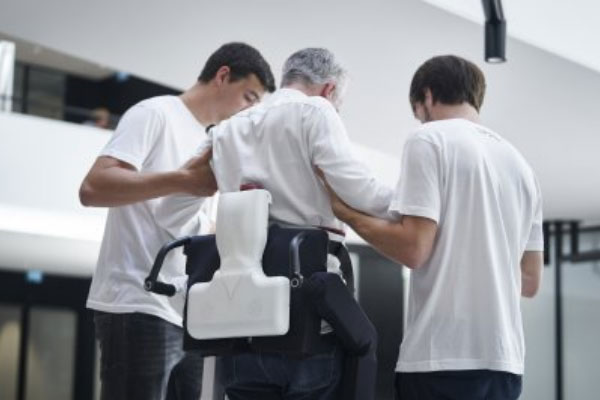Walking without crutches – this is something that people with certain neuromuscular disorders dream of. With the exoskeleton "Autonomyo”, this dream can now be made a reality.
 Regaining the Ability to Walk Independently
Regaining the Ability to Walk Independently

Case Study from | FAULHABER MICROMO
With the exoskeleton "Autonomyo”, this dream can now be made a reality. The active walking aid supports the weakened muscles and enables an intuitive sequence of movements that mimics the natural sequence. The additional power is supplied by six micromotors. To facilitate a harmonious interaction between the exoskeleton and its user, FAULHABER developed an innovative all-in-one component motor with a torque sensor.
Medical science distinguishes between more than 800 different neuromuscular disorders. As the name suggests, they affect both the nerves and the muscles. Some have an impact on the whole body, while others only affect it in certain areas. Fortunately, however, the majority of these disorders are relatively rare. Many of the affected patients suffer from severely restricted mobility. This is because, even though these disorders have many different causes and develop in many different ways, they all have one thing in common: muscle weakness (muscular dystrophy), which is progressive in many cases.
"If the muscle weakness occurs in the legs, walking becomes increasingly difficult, and eventually it becomes impossible without something to lean on," explains Mohamed Bouri, Leader of the research group for Rehabilitation and Assistive Robotics (REHA Assist) at the Swiss technical university of Lausanne (EPFL). "The muscles are still functional but they cannot muster enough strength for the patients to stand stably or move their legs independently. As you would expect, this has an enormous impact on the patient's range of movement and quality of life. The effects are similar to those of hemiplegia after a stroke. Our aim was to overcome these limitations as much as possible using motorized support –– therefore, still taking advantage of the patient’s contribution to his own movements.”
Lightweight partial assistance
The group leader is referring to conventional exoskeletons already in use leaning on humanoid inspired technology. These devices enable paraplegic people to walk without a crutch, but they weigh more than 40 kilograms. With only 25 kilograms, “Autonomyo” developed by REHA Assist is much lighter, and it works with the patient's weakened but still partially functioning musculoskeletal system.
The device is fastened with a corset around the trunk and cuffs around the legs of the user. On each side, three motors enable movement by supplying the power that the muscles are lacking. In each case, one motor is responsible for the flexion and extension of the hip and another motor does the same for the knee. The third motor supports abduction and adduction of the leg at the hip joint – in other words, the lateral movement of the leg away from the midline of the body. All together, the motors help the patient to maintain their balance and to walk upright. In a recently conducted clinical study including persons with walking impairment, Autonomyo proved to be working as intended: The exoskeleton provided support while allowing freedom of movement, following the users’ intentions. The range of joint motion and gait cadence were not negatively affected.

Feedback from the magnetic measurement system
It is absolutely crucial that the device assists gait according to the user’s intention. "The initial trigger to change position – that is, to start walking – is expressed as a small change in the lower limb position," explains Mohamed Bouri. "We detect it by combining the information from an inertial measurement unit, eight load sensors at the soles and the encoders of the motors that act as joint position sensors. All these data contribute to the assistance of balance." When walking, the interaction between the device and the user is crucial. A torque sensor developed by FAULHABER is responsible to sense this interaction and thus to precisely implement the assistance strategy.
"The project of integrating a precise torque sensor in a motor started a few years ago, aiming to promote applications such as Cobotics for safe human-robot interactions," explains Frank Schwenker, Group Leader for Advanced Engineering at FAULHABER. "With Autonomyo, we are able to implement the concept in a challenging assistive technology application for the first time."
The conventional technology for torque detection uses expansion strips on components; these strips are deformed by the force exerted. The weak point of their construction is the adhesive bond with which they are attached. The developers in the Advanced Engineering group have replaced these strips with a highresolution measurement system. " This enables us to achieve a deviation of less than 1.5 percent in the measurement range of plus/minus 30 newton meters," says Frank Schwenker. "The sensor therefore supplies a highly precise value for the response torque in the walking movement."
This value plays a vital role in controlling the Autonomyo exoskeleton, which is of course also supplied with numerous other values. "Adjusting the device to the individual patients requires very differentiated calibration of the entire system," explains Mohamed Bouri. "Using the various parameters and the feedback from the movement, the software calculates the control signals for the drives. The type and level of assistance from the motors are then determined based on these informations."

Drive power and development potential
The six drive units in each device are supplied by FAULHABER. Their core component is the 3274 BP4 brushless motor with a diameter of 32 millimeters. It offers the most power of any motor in its size class available on the market. Its power is transmitted by a 42 GPT planetary gearhead with a shaft produced especially for this application. A magnetic IE3 encoder supplies the position data to the controller. The torque sensor is integrated in the gearheads of the four motors for the flexion/extension movements.

FAULHABER BP4 BRUSHLESS DC-SERVOMOTORS
The requirements on the drive units are typical for top-of-the-range micromotors. High power with the smallest possible volume and weight, plus precision, reliability and a long service life are among the most important properties for this application. "It wasn't particularly difficult to find the right supplier," recalls Mohamed Bouri. "Having defined the specifications, the choice of possible motors was already reduced to just a small number of candidates. The astrophysics inter-faculty research group of our university already works with FAULHABER so they provided convincing recommendations, and a good relationship already existed. In addition, FAULHABER was already in a position to be able to develop the torque sensor within a short timeframe. That was very important for our project."

FAULHABER 42GPT PLANETARY GEARHEADS
For the time being, the component is not a series product and has so far been produced only for the EPFL in small quantities. However, development engineer Frank Schwenker can imagine many other areas of application: "High-resolution torque measurement can add significant value in all haptic applications. For example, for all types of robotic assistance in operating theaters where the surgeon guides the instrument and the machine controls the power and precision. The sensor can also provide a protective function and be used to limit torque. What's more, it is ideally suited to documentation processes in quality assurance in all cases where evidence of extremely precise torque values needs to be provided."
The content & opinions in this article are the author’s and do not necessarily represent the views of RoboticsTomorrow

FAULHABER MICROMO
Since 1961, FAULHABER MICROMO has partnered with OEMs to deliver high precision, high performance, custom micro motion system solutions to markets such as medical, robotics and automation in North America. FAULHABER MICROMO's tradition of innovation started decades ago in Germany. The groundbreaking invention of the FAULHABER coreless winding started it all for a market that produces millions of motors today. How can the FAULHABER MICROMO team help you deliver your next innovation to market first? Learn more about MICROMO's solutions for the most demanding applications, our diverse motion products and technologies, online ordering, Engineering and R&D teams, Clean Room Assembly, Machining Center and other services at our Clearwater, FL facility at https://www.faulhaber.com.
Other Articles
Walking naturally with artificial foot
Testing drive systems virtually - Simulink library for development and digital twin.
At least 60 million strokes
More about FAULHABER MICROMO
Comments (0)
This post does not have any comments. Be the first to leave a comment below.
Featured Product

